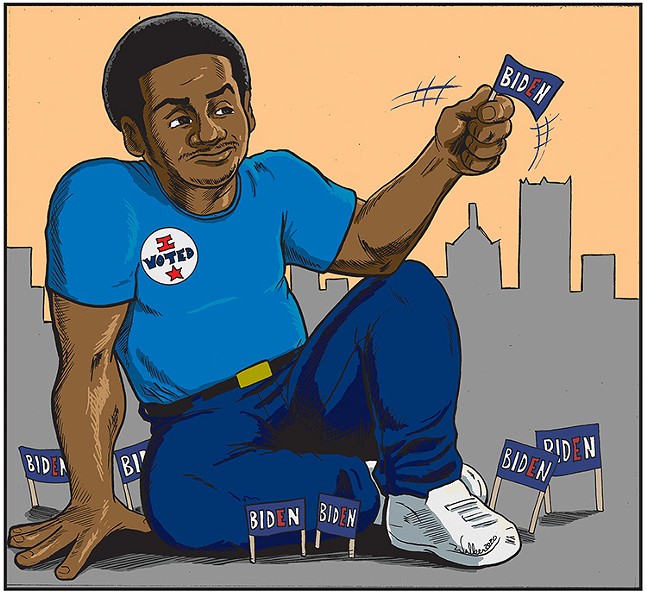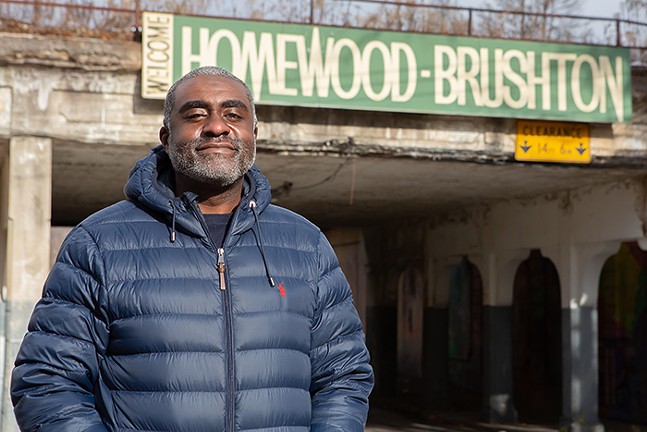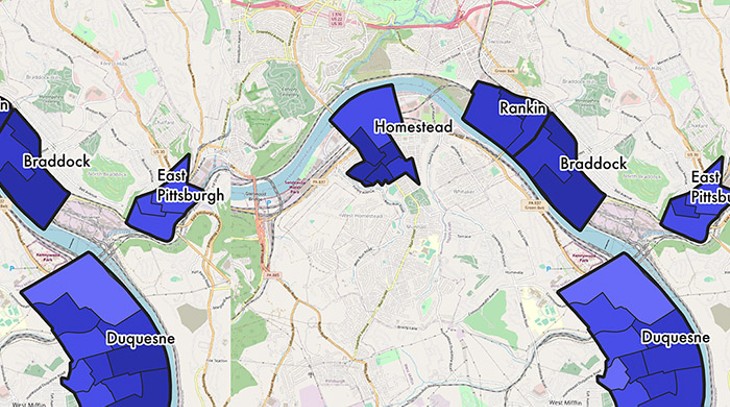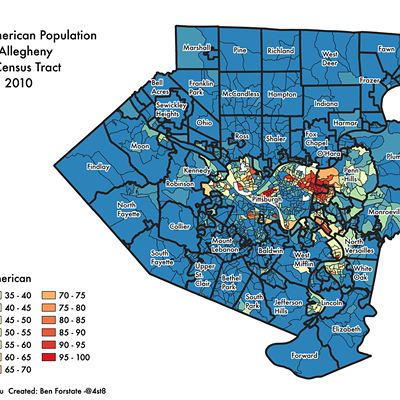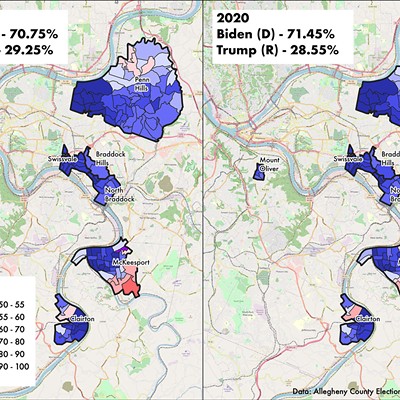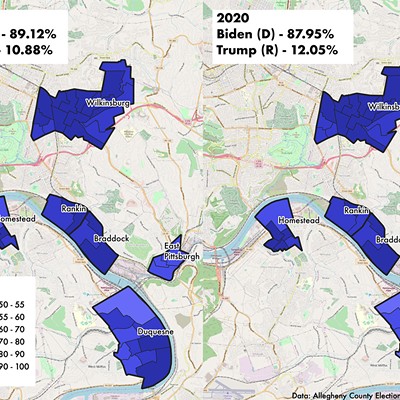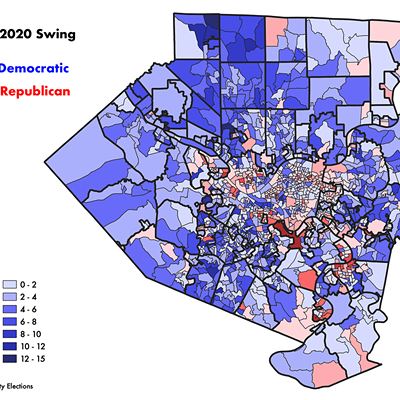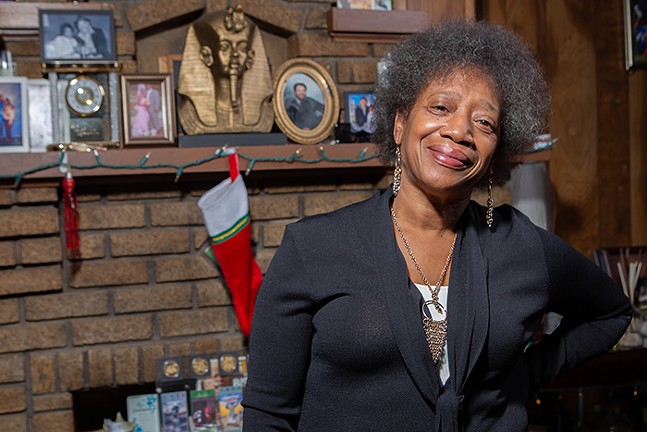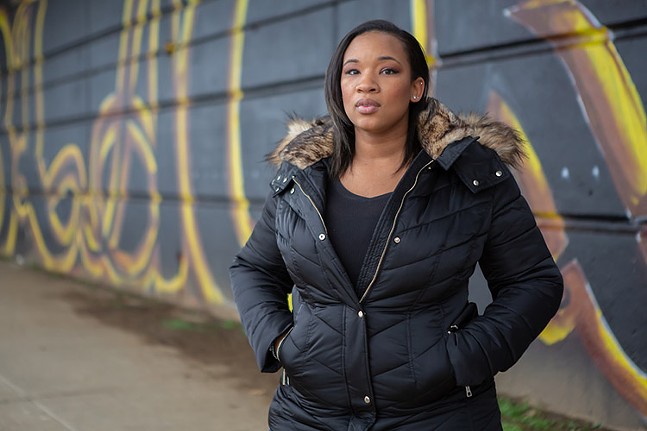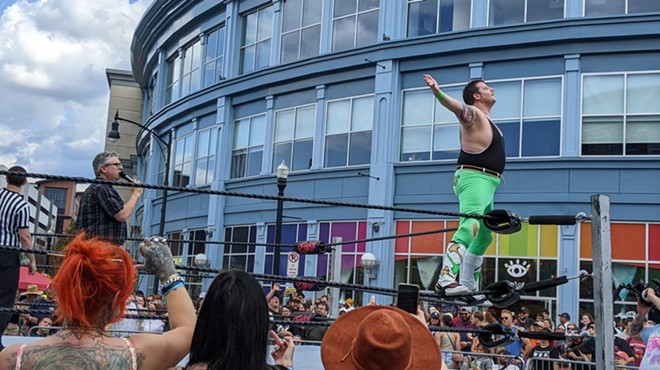However, Biden’s impressive victory comes with a caveat. The county’s Black community, who are easily the most loyal Democratic group among any demographic, wasn’t the reason for Biden’s astonishing success.
Many of Pittsburgh’s Black communities still supported Biden by overwhelming margins, with several neighborhoods giving Biden 90% of their vote and Allegheny County’s Black neighborhoods slightly increasing their overall votes for Biden in 2020 compared to Hillary Clinton in 2016. But President Donald Trump actually slightly improved his margins in many Black neighborhoods. Biden’s victory can mostly be attributed to his huge gains in mostly middle-to-upper income suburbs of Pittsburgh, which are overwhelmingly white.
Unlike many premature takes about Biden’s drop in support from urban Black voters, Allegheny County’s drop in Black vote margins for Biden is fairly complex. For one, in neighborhoods with significant Black populations (greater than 30% Black residents), turnout remained basically flat. Any drop in raw votes for Biden in Black areas can mostly be attributed to population loss, which many majority Black neighborhoods have been experiencing for some time. Correspondingly, precincts with more than 30% Black residents lost about 3,200 registered voters between 2016 to 2020.
However, while fewer voters led to a drop in votes for Biden in some places, it didn't lead to a drop in votes for Trump, who actually marginally increased his vote totals in Black neighborhoods. Additionally, Allegheny County as a whole significantly increased its voter turnout this year compared to 2016, while Black neighborhood turnout remained flat, prompting questions about voter enthusiasm among Black Pittsburghers. Turnout for the entire county jumped about six percentage points between 2016 and 2020, while turnout in precincts with significant Black populations grew less than a quarter of one percent.
Pittsburgh City Paper spoke with canvassers, elected officials, and advocates who live in majority Black neighborhoods, and who were well engaged with Black Pittsburghers this election cycle. They believe a myriad of reasons led to the subtle shifts in Pittsburgh’s Black electorate. They all praise the efforts of Black elected officials and organizers in getting out the vote for Biden, but acknowledge there was a wall with some potential voters where apathetic notions like “my vote doesn’t matter” were impossible to overcome.
Additionally, they say wide-scale misinformation painting Biden as anti-Black was effective among some Black voters, and that Biden’s own comments about the police didn’t always help. Finally, canvassers admit there were just some marginal gains in support for Trump in Black neighborhoods, particularly among Black men, which could have been thanks to Black celebrities meeting with the president, Trump’s promise of direct payments for a COVID-19 stimulus, or a general incumbency advantage.
And after years and years of population and economic decline in Pittsburgh’s Black neighborhoods, Black leaders are wondering just how long Black people will continue to show up to vote. They say that this year, in terms of Democratic support, it arguably could have been worse.
“We may have exhausted what we can get out of the electorate,” says Khari Mosley of 1Hood Media, which organized numerous Get Out the Vote efforts and canvassed for votes in Allegheny County’s Black precincts. “Even with someone like Trump in office, it was still difficult to get people to buy in that the political system was legit.”
Analyzing voting patterns based on race is not an exact science. Exit polls tend to be inaccurate and shallow. Larger studies require experienced academics, who require time. And by which time those studies are completed, many observers may be ready to move onto the next election. City Paper commissioned the help of local election analyst Ben Forstate to provide data somewhere in between those two analytical devices.
Allegheny County is extremely segregated along racial lines, which allowed CP to more easily compare data based on voting precincts and census tracts. These two data points largely overlap, but not perfectly. Forstate looked at 2010 Census data to determine which precincts were 30% or more Black, and which were 50% or more Black. Populations have likely changed since 2010, but decennial data is the most complete and accurate. As of the 2010 Census, the Black population made up about 13% of the Allegheny County’s population. Up-to-date census estimates show that percentage hasn’t changed much since 2010.
In all Allegheny County precincts where the Black population is 30% or greater, Biden secured 98,111 votes, which was a 1,239 vote increase compared to Clinton in 2016. Trump received 24,346 votes in Black neighborhoods, which was a 768 vote increase compared to his performance in 2016. Overall, Biden won Allegheny County’s Black neighborhoods by a margin of about 80-19. Both presidential candidates very slightly improved their vote totals from 2016, but Trump made a tiny improvement of 0.3% of the vote share, while Biden dropped 0.3% compared to Clinton. Trump improved slightly, but the story is more that Black neighborhoods didn’t increase their turnout for Biden as much as white neighborhoods.
In Allegheny County neighborhoods with less than 30% Black residents, Biden added 62,586 votes compared to Clinton, while Trump added only 23,020 votes compared to 2016. Predominantly white neighborhoods voted for Biden by a margin of about 56-43. In these whiter neighborhoods, Biden improved by a margin of 2.85% compared to Clinton, while Trump declined by 2.85%.
Interestingly, Biden’s underperformance among Black voters appears to be concentrated in the City of Pittsburgh and the precincts with the highest percentages of Black residents. Suburbs with 30% or more Black residents actually added more votes for Biden, and limited Trump’s marginal gains to about 0.1%. But Black precincts within Pittsburgh city limits (those with more than 50% Black residents) decreased vote totals for Biden compared to Clinton.
This could be a signal of Black displacement, as many Black Pittsburghers have moved to the suburbs in search of more affordable housing options, and many of those are suburbs with 30%, but not a majority, of Black residents. However, precincts outside of Pittsburgh city limits with more than 50% Black residents also saw a drop in total votes for Democratic presidential nominees. And Trump improved on his margins in municipalities with majority Black residents, like Wilkinsburg, Homestead, Braddock, and Rankin, by 2.3%.
Apathy and exhaustion
Mosley recognizes the small gains Trump received in Black neighborhoods, but he also acknowledges the wide-scale efforts to drum up support for Biden among Black Pittsburghers. 1Hood hosted three events in Black neighborhoods before the election to encourage people to vote by mail, return their ballots, and register to vote. These events included entertainment and free food in addition to voting help. He notes that “African Americans still vote overwhelmingly for Democrats” and that no other demographic comes close to their amount of support. Black elected officials, advocates, and unions all helped organize voter registration drives and canvassed Black neighborhoods, but he acknowledges those efforts eventually hit a wall.
“You have a portion of folks that have just totally bought out of the process,” says Mosley. “Even with that effort, I feel like what we did was a success, but there were forces that were working against enthusiasm.”
Olivia Bennett is an Allegheny County councilor and resident of Northview Heights, a majority Black neighborhood in Pittsburgh’s North Side. She says Black organizers were working to get more voters registered and to boost turnout, but voters she encountered were not necessarily excited about Biden.
“The ones I heard that were voting were because they understand that [voting] is a tool to move to the changes we want to see,” says Bennett. “But those who were not voting, they didn’t believe none of these candidates would move along the Black agenda.”
Hill District resident Sharon Thomas works as a cleaner at the PNC Tower. She canvassed with her union SEIU in support of Biden and says that most Black people understand that Trump was against their interests and voted accordingly. The Hill District went 94-5 in favor of Biden. But she also acknowledged the difficulties of getting more votes for Biden than Clinton.
“There were a lot of people that did not want to vote at all,” says Thomas. “There are still people that feel like their vote don’t count.”
The Hill District is Pittsburgh’s most historic Black neighborhood. In 2020, voters there cast 4,870 ballots for Biden, just 33 more than Clinton received in 2016. Trump only received 277 votes in 2020, but 53 more than he received in 2016.
Tanisha Long of Black Lives Matter Pittsburgh and Southwestern Pa. also worked to register and canvass Black voters. She applauds the efforts of Black leaders, and those of 1Hood, but came across similar roadblocks in convincing disinterested Black voters to participate.
She believes the chaotic nature of Trump’s campaign, COVID-19 restrictions, the low-key messaging of the Biden campaign, and general hardships that many Black Pittsburghers experience led to voter apathy. Studies show the disparity between Black and white Pittsburghers’ economic opportunity is among the largest of any metro area in America.
“It is very hard to convince people who have been moved out of their neighborhood to participate in the political system,” says Long.
She recognizes Biden’s strategy as effective overall (his gains in white and suburban Allegheny County are impressive), but notes that strategy doesn’t necessarily also lead to boosted Black turnout. “I consider him like a vanilla wafer, it's good in banana pudding, but just meh on its own,” says Long of Biden and his campaign.
Misinformation and campaign strategy
Mosley says there wasn’t just one reason for the apparent Black-voter apathy towards Biden, and instead it was a combination of many things. He says misinformation can’t be discounted, and Bennett agrees. Bennett says people in Northview Heights mentioned social media posts that posited Biden had once referred to Black people as “super predators.” Those posts were doctored, and Biden never used that specific term, but it was shared enough that many Black people believed it anyway.
“For me, I am trying to have conversations that try to demystify politics,” says Bennett. “A lot of conversations among neighbors included people saying ‘Well yeah, dude called us super predators.’” Aside from the effectiveness of doctored smears against Biden, the president-elect’s own record of supporting the crime bills of the 1990s and his strong repudiation of the “Defund the Police” movement also might have cost him Black Pittsburgh votes.
Biden reiterated several times during the campaign that he didn’t support defunding police departments after Trump repeatedly claimed he did. And while white Americans are generally against defunding the police, Black Americans are in favor of defunding police by an average of 45%, while only 28% are opposed, according to FiveThirtyEight.
Long says after the energy of the local Black Lives Matter movement, which protested for several months throughout the summer, that messaging from Biden was “disheartening” for the Black community.
“We are all marching and taking to the streets for Black and Brown people that have been killed,” says Long. “It feels like an uneven contract.”
Trump gains
It wasn’t just misinformation and Biden’s campaign strategy that led to marginal gains for Trump among Black Pittsburghers. Some of those gains (if extremely small) are explained by actual growth in support for Trump himself. Mosley and Bennett both cite conversations with voters about how celebrities like Lil Wayne, Ice Cube, and Kanye West took meetings with Trump.
Bennett says the vast majority of Black people criticized these actions, but both Bennett and Mosley say these actions might have moved some voters, and at the very least, it was a topic that was widely discussed in the Black community.
Another incident that Bennett believes had an impact on Trump making minor gains was the president’s tweet in October promising to provide a second round of $1,200 checks to Americans as part of the coronavirus stimulus. The Biden campaign also supported direct-cash stimulus, as well as student loan forgiveness, and social security payment increases. But Trump hogged headlines in October over his announcement, even though he was unsuccessful in convincing Republicans in Congress to agree with him.
“If Trump wins the election, people are voting for the $1,200,” says Bennett. “Those were conversations I was having in Northview and in Spring Hill.”
Obviously, none of this hurt Biden in Allegheny County. He won the election quite handedly. But it appears his campaign was mostly viewed as a “back to normal” mindset, which was more effective in swaying and turning out wealthy, white suburbanites than Black Pittsburghers. Compound that with how Pittsburgh is one of the worst regions for Black people in terms of opportunity, and it's easy to see why “back to normal” is actually a pejorative sentiment among Black Pittsburghers.
Mosley recognizes this dichotomy, and understands that it takes a generationally talented politician to motivate both white people and Black people in Pittsburgh, even if that isn’t necessary to win Allegheny County and Pennsylvania.
“Enthusiasm for Biden was in response to his opponent,” says Mosley. “Generational political figures are just that. I don’t know when the next [Barack] Obama is gonna come around.”
Thomas recognizes that boosting turnout with a candidate who can break through the apathy is an uphill battle, acknowledging that it was more difficult to persuade people this year than in previous campaigns.
“They have a trust issue, more now than before,” says Thomas. “[Politicians] say one thing and they do something else.”
Long sees Trump’s small gains, and Biden’s flat turnout among Black Pittsburghers, not necessarily as a failure, but as a warning. This year had a historic civil rights movement centered on Black people, as well as energy among Black officials and organizers to do everything they could to bring out voters. She says voter turnout among Black Pittsburghers could have been worse.
“What would it look like if we weren’t out here doing the things that we were doing?”

